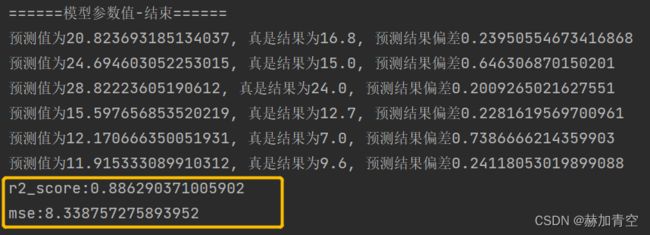机器学习实践(2.2)LightGBM回归任务
前言
LightGBM也属于Boosting集成学习模型(还有前面文章的XGBoost),LightGBM和XGBoost同为机器学习的集大成者。相比越来越流行的深度神经网络,LightGBM和XGBoost能更好的处理表格数据,并具有更强的可解释性,还具有易于调参、输入数据不变性等优势。
机器学习实践(1.2)XGBoost回归任务
机器学习实践(2.1)LightGBM分类任务
❤️ 本文完整脚本点此链接百度网盘链接获取 ❤️
一.轻松实现回归任务
1.1导入第三方库、数据集
"""第三方库导入"""
from lightgbm import LGBMRegressor
from sklearn import datasets
from sklearn.model_selection import train_test_split, GridSearchCV
from sklearn.metrics import r2_score, mean_squared_error
import lightgbm as lgb
"""波士顿房价数据集导入"""
data = datasets.load_boston()
# print(data)
"""训练集 验证集构建"""
X_train, X_test, y_train, y_test = train_test_split(data.data, data.target, test_size=0.2,
random_state=42)
sklearn的波士顿房价数据集共506个数据样本,8:2切分后,训练集404个数据样本,验证集102个数据样本。数据集中包括 样本特征data(13个特征)、特征名称feature_names、样本标签target(MEDV)、以及数据集位置filename(~~~\anaconda\lib\site-packages\sklearn\datasets\data\boston_house_prices.csv)
特征名称和标签解释如下:
- CRIM per capita crime rate by town\n # 按城镇划分的犯罪率
- ZN proportion of residential land zoned for lots over 25,000 sq.ft.\n # 划分为25000平方英尺以上地块的住宅用地比例
- INDUS proportion of non-retail business acres per town\n # 每每个城镇的非零售商业用地比例
- CHAS Charles River dummy variable (= 1 if tract bounds river; 0 otherwise)\n # 靠近查尔斯河,则为1;否则为0
- NOX nitric oxides concentration (parts per 10 million)\n # 一氧化氮浓度(百万分之一)
- RM average number of rooms per dwelling\n # 每个住宅的平均房间数
- AGE proportion of owner-occupied units built prior to 1940\n # 1940年之前建造的自住单位比例
- DIS weighted distances to five Boston employment centres\n # 到波士顿五个就业中心的加权距离
- RAD index of accessibility to radial highways\n # 辐射状公路可达性指数
- TAX full-value property-tax rate per $10,000\n # 每10000美元的全额财产税税率
- PTRATIO pupil-teacher ratio by town\n # 按城镇划分的师生比例
- B 1000(Bk - 0.63)^2 where Bk is the proportion of blacks by town\n # 1000(Bk-0.63)^2其中Bk是按城镇划分的黑人比例
- LSTAT % lower status of the population\n # 人口密度
- MEDV Median value of owner-occupied homes in $1000's\n # 住房屋的中值(单位:1000美元)
1.2模型训练
"""模型训练"""
model = LGBMRegressor()
# r2_score:0.886290371005902
# mse:8.338757275893952
# 给定参数
# model = LGBMRegressor(boosting='gbdt', # gbdt \ dart
# n_estimators=300, # 迭代次数
# learning_rate=0.1, # 步长
# max_depth=10, # 树的最大深度
# seed=42, # 指定随机种子,为了复现结果
# )
# r2_score:0.9043019057586194
# mse:7.017903291953562
model.fit(X_train, y_train)
LGBMRegressor()是没有指定参数,模型使用默认参数如下。也可以指定参数例如指定boosting='dart'等。训练的模型参数如下:
parameters:
[boosting: gbdt]
[objective: regression]
[metric: l2]
[tree_learner: serial]
[device_type: cpu]
[data: ]
[valid: ]
[num_iterations: 100]
[learning_rate: 0.1]
[num_leaves: 31]
[num_threads: -1]
[deterministic: 0]
[force_col_wise: 0]
[force_row_wise: 0]
[histogram_pool_size: -1]
[max_depth: -1]
......
1.3模型验证
模型效果的验证,简单直接的可以通过验证集来实现。实际项目中通常将整个数据集按照7:3:1比例划分为训练集、验证集、测试集。本例使用验证集验证模型准确性。
回归任务的评估指标只要有 r2_score 和 mse,其中 r2_score 越趋近于1越好,mse 越小越好。
R2 = 1 - (SSE / TSS),其中,SSE(sum of squared errors )是模型预测值与实际观测值之间差异的平方和,TSS(total sum of squares)是所有观测值与其均值差异的平方和。
y_pred = model.predict(X_test)
# print(y_pred)
for m, n in zip(y_pred, y_test):
if m / n - 1 > 0.2:
print('预测值为{0}, 真是结果为{1}, 预测结果偏差大于20%'.format(m, n))
def metrics_sklearn(y_valid, y_pred_):
"""模型效果评估"""
r2 = r2_score(y_valid, y_pred_)
print('r2_score:{0}'.format(r2))
mse = mean_squared_error(y_valid, y_pred_)
print('mse:{0}'.format(mse))
"""模型效果评估"""
metrics_sklearn(y_test, y_pred)
二.模型调参
def adj_params():
"""模型调参"""
params = {
'n_estimators': [100, 200, 300, 400],
# 'learning_rate': [0.01, 0.03, 0.05, 0.1],
'max_depth': [5, 8, 10, 12]
}
other_params = {'learning_rate': 0.1, 'seed': 42}
model_adj = LGBMRegressor(**other_params)
# sklearn提供的调参工具,训练集k折交叉验证(消除数据切分产生数据分布不均匀的影响)
optimized_param = GridSearchCV(estimator=model_adj, param_grid=params, scoring='r2', cv=5, verbose=1)
# 模型训练
optimized_param.fit(X_train, y_train)
# 对应参数的k折交叉验证平均得分
means = optimized_param.cv_results_['mean_test_score']
params = optimized_param.cv_results_['params']
for mean, param in zip(means, params):
print("mean_score: %f, params: %r" % (mean, param))
# 最佳模型参数
print('参数的最佳取值:{0}'.format(optimized_param.best_params_))
# 最佳参数模型得分
print('最佳模型得分:{0}'.format(optimized_param.best_score_))
adj_params()
2.1网格搜索调参
params = {
'n_estimators': [100, 200, 300, 400],
# 'learning_rate': [0.01, 0.03, 0.05, 0.1],
'max_depth': [5, 8, 10, 12]
}
other_params = {'learning_rate': 0.1, 'seed': 42}
调参内容不是很多时,例如本次调参训练80次,两个参数值可以一起调整,结果如下图:

调参是个无穷无尽的过程,适可而止,切误沉溺其中本末倒置,真正决定模型效果上限的还是数据质量
2.2调参结果入模
model = LGBMRegressor(boosting='gbdt', # gbdt \ dart
n_estimators=200, # 迭代次数
learning_rate=0.1, # 步长
max_depth=5, # 树的最大深度
seed=42, # 指定随机种子,为了复现结果
)
model.fit(X_train, y_train)
基础模型boosting='gbdt',最大深度max_depth=5, 迭代次数n_estimators=200 参数入模,fit()训练带参的模型,模型的参数和评估见下方(三.模型保存、加载、调用预测)

三.模型保存、加载、调用预测
3.1模型保存、加载、调用预测
"""模型保存"""
model.booster_.save_model('lgb_regressor_boston.txt')
"""模型加载"""
rgs = lgb.Booster(model_file='lgb_regressor_boston.txt')
"""模型参数打印"""
print('模型参数值-开始'.center(20, '='))
# lightgbm模型参数直接打开模型文件查看更为方便
model_params = rgs.dump_model()
print(model_params)
print('模型参数值-结束'.center(20, '='))
"""预测验证数据"""
y_pred = rgs.predict(X_test)
"""模型效果评估"""
metrics_sklearn(y_test, y_pred)
3.2模型参数
经过上面脚本’lgb_regressor_boston.txt’是已经保存到本地的模型文件,可以打开文件查看参数,其中
最开始是 树tree 的信息;
tree
version=v3
num_class=1
num_tree_per_iteration=1
label_index=0
max_feature_idx=12
objective=regression
feature_names=Column_0 Column_1 Column_2 Column_3 Column_4 Column_5 Column_6 Column_7 Column_8 Column_9 Column_10 Column_11 Column_12
feature_infos=[
每个tree信息都会存在,trees之后是feature_importances特征重要性信息,几乎在文件末尾;
......
end of trees
feature_importances:
Column_12=289
Column_7=237
Column_5=230
Column_6=174
Column_0=155
Column_11=140
Column_4=138
Column_9=97
Column_10=68
Column_2=38
Column_3=34
Column_1=21
Column_8=16
结尾是 parameters 参数和 pandas_categorical pandas经过虚拟化的类别信息。
parameters:
[boosting: gbdt]
[objective: regression]
[metric: l2]
[tree_learner: serial]
[device_type: cpu]
[data: ]
[valid: ]
[num_iterations: 200]
[learning_rate: 0.1]
[num_leaves: 31]
[num_threads: -1]
[deterministic: 0]
[force_col_wise: 0]
[force_row_wise: 0]
[histogram_pool_size: -1]
[max_depth: 5]
[min_data_in_leaf: 20]
......
end of parameters
pandas_categorical:null
附加——深入学习XGBoost
附加1.模型调参、训练、保存、评估和预测
见《XGBoost模型调参、训练、评估、保存和预测》 ,包含模型脚本文件
附加2.算法原理
见《XGBoost算法原理及基础知识》 ,包括集成学习方法,XGBoost模型、目标函数、算法,公式推导等
附加3.分类任务的评估指标值详解
见《分类任务评估1——推导sklearn分类任务评估指标》,其中包含了详细的推理过程;
见《分类任务评估2——推导ROC曲线、P-R曲线和K-S曲线》,其中包含ROC曲线、P-R曲线和K-S曲线的推导与绘制;
附加4.模型中树的绘制和模型理解
见《Graphviz绘制模型树1——软件配置与XGBoost树的绘制》,包含Graphviz软件的安装和配置,以及to_graphviz()和plot_trees()两个画图函数的部分使用细节;
见《Graphviz绘制模型树2——XGBoost模型的可解释性》,从模型中的树着手解释XGBoost模型,并用EXCEL构建出模型。
附加5.XGBoost实践
见机器学习实践(1.1)XGBoost分类任务,包含二分类、多分类任务以及多分类的评估方法。
见机器学习实践(1.2)XGBoost回归任务,包含回归任务模型训练、评估(R2、MSE)
见机器学习实践(2.1)LightGBM分类任务,包含LightGBM二分类、多分类任务及评估方法。
❤️ 机器学习内容持续更新中… ❤️
声明:本文所载信息不保证准确性和完整性。文中所述内容和意见仅供参考,不构成实际商业建议,可收藏可转发但请勿转载,如有雷同纯属巧合。

